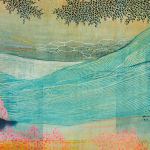Business of Art | Five Art World Insights from Long-Time Gallerist and Collector Michael Findlay
Findlay, a NYFA Board Member and Director of Acquavella Galleries, shares top tips for artists navigating their careers in the time of COVID.
The COVID-19 pandemic has left many in the arts community reeling and adapting to an increasingly digital world. Through the immense challenges brought forth by the pandemic and the realities of being part of the creative community, artists continue to navigate how to get their work seen by curators and collectors. Michael Findlay, NYFA Board Member and Director of Acquavella Galleries, recently offered his insights into how to approach curators, what makes for a successful website, and how to value your work.
Findlay brings more than 50 years of experience to the conversation. In the 1960s and 1970s, he directed one of the first galleries in Soho and was the first dealer in the United States to show the work of Joseph Beuys, Sean Scully, and other European artists. From 1984-2000, he supervised the sales of many important collections at Christie’s, opening the auction house’s Shanghai office in 1994. He has been Director of Acquavella Galleries since 2000; the gallery specializes in Impressionist and Modern European works of art and post-war American painting and sculpture.
1. Make Connections with Curators
Many museums are becoming more focused on local and regional artists—those who are within reach of the institution. Curators are paying more attention to artists within their backyards as they explore the possibility of exhibitions that are easy to produce with limited time and budgets. Findlay suggests finding an email for a curatorial staff member and reaching out directly with an introduction. Share your website or invite them for a virtual studio visit. “A direct approach is never a miss,” says Findlay. If you do have representation, work closely with your gallery rep to make sure they’re actively promoting your work.
2. Perfect Your Website to Tell Your Story
The pandemic has pushed the art world even further online, making it paramount that you have a functioning, updated, and visually-appealing website. “The artist should be in control of the way that they are seen online,” says Findlay, and having a website enables you to do this. When Findlay visits an artist’s website, he first goes to the work. He suggests arranging the work chronologically so that it helps tell the story of your career. “Clear images are the most important thing,” he emphasized. Findlay next looks at the artist’s bio. While some in the art industry may pay attention to an artist’s educational background, Findlay is not interested in it “in the least,” saying “for me, the credential is the work.” Other items you could think about including are your agent if you are currently represented by a gallery and videos of you at work and talking.
3. Valuing Your Work
Many artists struggle with valuing their work. Findlay wisely points out that everyone is affected by the idea of price equaling worth, however he cautions that “you can always go up, but you can never go down” as an artist moving forward in their career. Findlay also notes that it is better to have more people paying less than fewer people paying more. He strongly suggests that artists have paintings, prints, and drawings available between a few hundred and a few thousand dollars. “This is an amount of money that emerging collectors can afford to spend,” advises Findlay. Collectors at the lower level are more likely to buy what they like, as opposed to those at the higher level who are more investment-conscious. For artists of all levels, Findlay advises to speak your truth through your art instead of catering to what’s trending. “The work is the work is the work is the work; that’s what collectors are buying,” he says.
Once you determine a price for your work, put it out there. According to Findlay, 35% of art sales are to new online buyers. With that, 81% of collectors buying online want to see prices (source: The Impact of COVID-19 On The Gallery Sector), especially new collectors who are intimidated by the process. You should also make sure to leave room for negotiation when pricing your work.
4. Networking is Essential
You may find yourself asking the question: “How does a curator/gallery director/collector find me?” To this, Findlay says that networking is essential. He looks up the names of artists he hears of from other artists, often those who are somewhat better known. “If you have any engagement with other artists, a degree of collegiality can help,” he says. Findlay recognizes that the life of an artist is mostly solitary, but stresses the importance of getting out of your studio and experiencing and interacting with the work of other artists. Even if the artist is pursuing art in very different ways, Findlay underscores the need for visiting others’ studios.
5. The Real Estate Silver Lining
Findlay predicts that New York’s real estate market has room to grow for the next generation of art and artists in Manhattan and Brooklyn. “Six months ago, there was no real estate for an artist studio or small gallery,” he says. With many empty storefronts and lower rents, there may soon be more opportunities for artists to put on their own group shows or create co-op galleries (like CANADA, for example) to showcase their work and the work of those in their communities. “Out of the way places whet the appetites of new collectors who are looking for something special,” Findlay added.
– Amy Aronoff, Senior Communications Officer
You can find more articles on arts career topics by visiting the Business of Art section of NYFA’s website. Sign up for NYFA News and receive artist resources and upcoming events straight to your inbox.Have an arts career question? You can contact NYFA staff directly by emailing [email protected].





